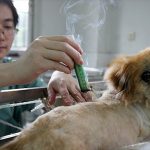The Mystery of the Siamese Cat’s Whiskers
This past summer I noticed something different about my Siamese cat, Poppy. Now, she’s a seal point apple-head with dark brown face mask, ears, tail, and legs. Your typical Siamese looking cat with bright blue crossed eyes. But then I saw she was going gray. Her cheeks—where all her whiskers are—turned white!
(If you look at the recent photo of Poppy to the left and compare it to the photo on the title page you can see the color change).
Poppy is 11 years old, and maybe age is turning her gray. But I’ve had cats— including another seal-point Siamese—who have lived into their twenties without any change or lightening in the color of their fur.
So, I needed to investigate this.
I know there’s a condition where the fur of a black cat will develop a reddish tint if their diet lacks the amino acid tyrosine. Now, you ask: what’s tyrosine and what does it do? Tyrosine is an aromatic amino acid that the cat synthesizes from phenylalanine (another amino acid). Basically, tyrosine is needed to make melanin, which is the major pigment in cats’ skin and hair.
But my cat eats a diet of raw meat and organs and tyrosine is abundant in raw meat (also, in eggs and dairy). So, could there be another explanation?
What I found out is that cats of the Himalayan breeds (color points, minks, sepias, or semi-albinos) have heat-sensitive tyrosinase. Normal tyrosinase converts the amino acid tyrosine into melanin (pigment). In Himalayan cats, this enzyme denatures at normal body temperatures and the color is formed only on the cooler extremities of the body (legs, tail ears, face). This is why Siamese cats get darker in winter and paler in summer. If you put legwarmers on your Siamese for several weeks (like that’s possible) you would see patches of white markings on its leg and paws.
So, why haven’t I noticed this before? The only reason I can think of is, this past summer was hotter for a longer number of days than previous summers. And my Siamese insists on sleeping in my bedroom and in the summer it is the warmest room in the house (I have no AC in there, only a window fan. The AC is in the living room). She absolutely refuses to sleep in an air-conditioned room. It’s no wonder her cheeks turned white!
Now that autumn is here the weather is cooler, and so is her favorite sleeping spot in my bedroom. Her cheeks are darker now. So, everything is back to normal. Whew! So, I was worried over nothing.
But, could a cat have a tyrosine deficiency?
In 1986, the NRC “recommended a dietary concentration of 4.0 g/kg of phenylalanine and 8.5 g/kg of total aromatic amino acids for growing kittens on the basis of maximal growth rate and nitrogen balance” (PubMed). However, it’s been shown that the above amount is not sufficient in keeping a black cat black. They needed to ingest more than 16g per kg of phenylalanine + tyrosine to maintain or restore a black cat or kittens rich coat color. Levels less than 16g resulted in reddish fur on the black cat (NOTE: the NRC recommends an aromatic amino acid concentration of 18 g/kg or higher for the prevention of red hair in black-coated cats).
If you’re concerned about maintaining your cat’s coat color, please be careful with supplementation. If a cat ingests too much tyrosine then the cat’s coat will darken more than it should (for example: a brown cat—like a Burmese—may become almost black). And, besides there can be other conditions that may be causing color change in the fur.
And what are the other factors that could affect the melanin in the fur?
Copper Deficiency: One of the early signs of copper deficiency in cats is loss of hair color, or achromotrichia, and a change in texture of the hair. The reason for the color change is an alteration to the metabolism of tyrosine. Copper helps tyrosine work as a pigment factor.
Zinc Excess: Basically, too much zinc in the diet may cause a copper deficiency, which, in turn, can cause an iron deficiency. As a result of the copper deficiency, you end up with the above.
Warning: Do NOT give your cat zinc or copper supplements without the guidance of a veterinarian as they may directly or indirectly result in the formation of reactive oxygen species that cause oxidative damage, or Heinz bodies (HzB) which are aggregates of denatured, precipitated hemoglobin within red blood cells (RBC). In other words, HzB disease causes the destruction of red blood cells, and you will have a very ill cat.
The thyroid, kidneys & liver are three organs that can also effect coat color and they all interact with tyrosine. Tyrosine is metabolized in the liver and tyrosine is necessary for synthesizing thyroxin, a hormone produced by the thyroid gland.
Cats that should avoid tyrosine supplements are:
Cats with liver damage
Cats with an overactive thyroid (hyperthyroidism)
Cats with a malignant melanoma
Cats being treated for any serious illness or on any medications
Please be advised, never give any vitamin supplement to your cat without first consulting with a holistic veterinarian or animal naturopath.
A cat on a varied raw meat diet (with organs & bones) is going to get all the correct nutrients for health. When feeding a species appropriate diet there’s no guessing game about whether a nutrient is missing, or not. There’s no worrying if the cat is getting the correct amount, or not. All the nutrients are there in a prefect package…just the way Nature meant it to be.










